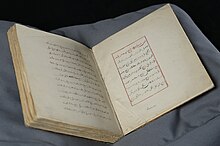Hikayat Aceh
This article has multiple issues. Please help improve it or discuss these issues on the talk page. (Learn how and when to remove these template messages)
|
| Hikayat Aceh | |
|---|---|
| National Library of Indonesia, Leiden University Library | |
| Date | 17th c. |
| Language(s) | Malay (Arabic script) |
The Hikayat Aceh is a 17th-century history of the Aceh Sultanate, which is located on the northern tip of the island of Sumatra, Indonesia. Written in Malay in the Arabic script it chronicles and eulogizes the Acehnese Sultan Iskandar Muda (1583-1636; reigned 1607–1636; national hero of Indonesia since 1993). The Hikayat Aceh is an indispensable tool for all interested in the history of Aceh and its exceptional political, cultural, and religious traits.
The narrative of Sultan Iskandar Muda is told against the global background of Chinese, Portuguese, and Ottoman-Turkish influences and relations in the world. It is set in a context where also Southeast Asian regions like Siam, Cambodia, and Johor play a role.
It is also though by Russian linguist, Vladimir Braginskiĭ, That the Hikayat Aceh were influenced by Mughal dynasty historiography, as he found out the literal structure similarities of Hikayat Aceh with Mahfuzat-i-Timuri, as the former has shared the similar theme with the latter about the lifetime and exploits of the protagonist of Mahfuzat-i-Timuri, Timur.[1] Braginskiĭ also found the similarities in structure of both Hikayat Aceh and Mahfuzat-i-Timuri with Akbarnama manuscript.[1]
Manuscripts[edit]
Only three manuscripts are still in existence. Two are kept in Leiden University Libraries (Dutch: Universitaire Bibliotheken Leiden), Leiden, the Netherlands, and one in the National Library of Indonesia (Indonesian: Perpustakaan Nasional Republik Indonesia, Perpusnas), Jakarta, Indonesia.
On 18 May 2023 these three manuscripts were inscribed in the UNESCO Memory of the World Register affirming their world significance and outstanding universal value.[2]
MS. Or. 1954[edit]

As the oldest (c.1675-1700) and most complete text, this is the central manuscript of the Hikayat Aceh and the one edited as manuscript A by Teuku Iskandar (1958).[3] The manuscript is kept in Leiden University Libraries and has been digitized.[4]
MS. Or. 1983[edit]

This is a copy of Or. 1954 in Batavian Malay dated 9 March 1847 and used as manuscript B in Teuku Iskandar (1958).[5] The manuscript is kept in Leiden University Libraries and has been digitized.[6]
MS. ML 421[edit]
This is another copy of Or. 1954, dating from the early 20th century, and probably intended as the basis for a text edition of the Hikayat Aceh by Hoesein Djajadiningrat. The manuscript is kept in the National Library of Indonesia.
References[edit]
- ^ a b V.I. Braginsky (2005). The Heritage of Traditional Malay Literature: A Historical Survey of Genres, Writings and Literary Views. BRILL. p. 381. ISBN 978-90-04-48987-5. Retrieved 17 March 2024.
...author shares T. Iskandar's opinion that Hikayat Aceh was influenced by Mughal historiography..
- ^ "UNESCO Recognizes Manuscripts First Voyage Around the Globe and Hikayat Aceh as World Heritage". library.universiteitleiden.nl. Retrieved 18 May 2023.
- ^ Teuku Iskandar. "De Hikajat Atjéh". Nijhoff. Retrieved 19 May 2023.
- ^ "Hikayat Aceh Or. 1954". Leiden University Libraries. Retrieved 19 May 2023.
- ^ Teuku Iskandar. "De Hikajat Atjéh". Nijhoff. Retrieved 19 May 2023.
- ^ "Hikayat Aceh Or. 1983". Leiden University Libraries. Retrieved 19 May 2023.
